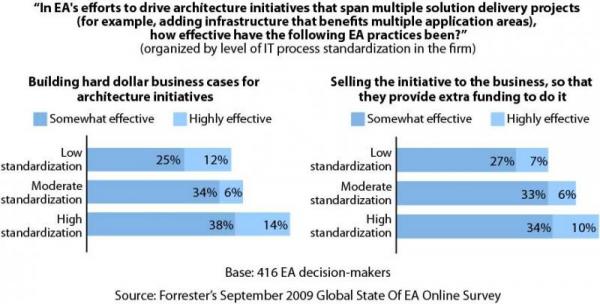Is EA Effectiveness At The Mercy Of Process Standardization?
When digging into the data from September 2009 Global State Of Enterprise Architecture Online Survey, I found an interesting correlation in the data: Survey respondents who reported a high degree of business and IT process standardization also reported that EA was more effective and more influential within the organization. As the level of standardization decreased, so did EA effectiveness and influence. Just take a look at this sample data from a report that recently went live on our website:

Why does this correlation exist? We’ve been saying (and most clients have been agreeing) that process standardization is a keystone to effectiveness across all areas of IT: apps, infrastructure, PMOs, you name it. When I look at IT organizations in my research, those that focus on standardizing processes or that live in an environment of highly standardized business processes tend to be doing a better job.
But simply being more standardized can’t be the “secret sauce” for EA success. There must be something that standardization does to an organization — a window or door that it creates — that enables IT functions such as EA to get better at what they do. Based on deeper analysis of our data, this is my hypothesis:
- Standardization gives EA the opportunity to define and leverage specialized roles. For example, what would a business architect do if business processes were entirely undefined, other than scramble to make sense of them? Having standardization in place gives EA roles the ability to take on a higher purpose and therefore gives the EA function a reason to define them in the first place. The data from our survey supports this: As standardization increased, so did the likelihood that these roles were defined in the central EA group.
- Standardization increases IT’s spend on new initiatives. On average, respondents with a low level of process standardization spent 34% of their IT budget on new projects and initiatives, versus 37% in highly standardized firms. Having standardization in place grants organizations the bird’s-eye view of IT spend that is necessary to make informed IT portfolio decisions. As a result, spend is better managed and more can be allocated to innovation and transformation. This translates to improved EA-business relations, more time spent with business peers, and better EA understanding of IT plans for spend and initiatives.
What do you think? If you have a high degree of IT and/or business process standardization in your firm, how has that helped your EA function? If you lack standardization, what has this prevented EA from achieving?